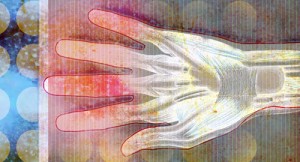 Individuals with hand osteoarthritis (OA) and a high body mass index (BMI) tend to have more severe pain in the hands, feet, knees and hips than individuals with OA and a normal BMI (18.5–24.9 kg/m2). Specifically, the investigators found that each five-unit increase in BMI was associated with more severe hand pain, foot pain, knee and hip pain, generalized pain and pain sensitization.
Individuals with hand osteoarthritis (OA) and a high body mass index (BMI) tend to have more severe pain in the hands, feet, knees and hips than individuals with OA and a normal BMI (18.5–24.9 kg/m2). Specifically, the investigators found that each five-unit increase in BMI was associated with more severe hand pain, foot pain, knee and hip pain, generalized pain and pain sensitization.
A study from Marthe Gloersen, MD, Diakonhjemmet Hospital and the University of Oslo, Norway, and colleagues indicates that systemic effects of obesity, as measured by leptin, may play a larger mediating role for pain in the hands than in the lower extremities. Their results, published in the March 2022 issue of Arthritis & Rheumatology, also suggest low-grade inflammation, as measured by high-sensitivity C-reactive protein (hsCRP), may contribute to generalized pain in overweight and obese individuals.1 The authors conclude their paper by suggesting weight loss may be a strategy to prevent or treat pain in individuals with hand OA.
Obesity Associated with Hand Pain
The cross-sectional, Nor-Hand study included 300 patients (19 of whom had missing plasma and serum samples) with a wide range of pain intensity in the hands, feet, knees and hips—but their highest pain intensity was in the hands. The study population was predominately women (89%), and the patients had a median age of 61 years. The investigators analyzed serum for hsCRP and matrix metalloproteinase–dependent degradation of C-reactive protein (CRPM). They measured hsCRP on an ADVIA 1800 platform using a CardioPhase hsCRP assay according to the manufacturer’s instructions.
For every five-unit increase in BMI, hand pain measured by the Australian/Canadian Osteoarthritis Hand Index (AUSCAN) increased by 0.64 (95% confidence interval [CI] 0.23, 1.08). Estimates of the total effects per standard deviation (13.1 cm) increase in waist circumference on pain were in similar magnitude to the estimates reported for BMI.
“Our findings suggest the systemic effects of obesity play a role in hand pain,” says Dr. Gloersen. Although she expected that higher BMI would contribute to pain in the lower extremities, she found the association between BMI and pain in the hands, although modest, to be noteworthy. Although such a positive association between BMI and hand pain has been shown in previous cross-sectional studies, longitudinal studies have not been able to demonstrate that baseline BMI or changes in BMI are associated with hand pain.2,3
What Drives the Association?
The current study repeated the established finding that overweight (BMI of 25–29.9 kg/m2) and obese (BMI of ≥30 kg/m2) individuals are more likely to have elevated CRP levels compared with persons of normal weight.4 Next, the researchers analyzed the following inflammatory biomarkers: hsCRP, matrix metalloproteinase-dependent degradation of CRP (CRPM), interleukin (IL) 1β, IL-1 receptor antagonist (IL-1Ra), IL-4, IL-6, IL-10, IL-12, IL-17, IL-18, IL-21, interferon-ɣ, tumor necrosis factor (TNF), vascular endothelial growth factor, granulocyte-macrophage colony-stimulating factor (GM-CSF), CCL2, CCL3, CCL4, CXCL10, leptin and resistin.
When the researchers performed mediation analyses, they found the effects of BMI on hand pain and painful total body joint count were partially mediated by leptin and hsCRP, respectively. This finding is consistent with a previous meta-analysis, which found a significant correlation between levels of hsCRP and joint pain.5 However, the effects of BMI on measures of central pain sensitization did not appear to be mediated through hsCRP or any of the other inflammatory biomarkers, including leptin. The data also suggest that none of the inflammatory biomarkers mediated the association between BMI and the presence of widespread pain.
“We measured a large number of inflammatory biomarkers in serum/plasma to explore whether the observed associations between BMI and pain could be explained by systemic low-grade inflammation,” says Dr. Gloersen. “To our surprise, the majority of the inflammatory biomarkers did not mediate the association between BMI and pain, suggesting systemic low-grade inflammation mediates this association to a lesser extent than what we hypothesized before conducting the study. However, [because] we looked at each biomarker separately, we cannot rule out that combinations of certain biomarkers in the mediation analyses could have led to different results.”
The researchers found the effect sizes for mediation by leptin were larger for the hands than for the lower extremities and were statistically significant for only the hands.
“We believe the role of leptin is more important in the hands than in the lower extremities, due to the biomechanical effects of obesity being the dominating mechanism behind the observed association between BMI and pain in the lower extremities,” says Dr. Gloersen. “In contrast to the knee and hip joints, the hand joints are non-weight bearing, and the systemic effects of obesity may, thus, play a more important role in the association between BMI and hand pain.”
Lara C. Pullen, PhD, is a medical writer based in the Chicago area.
References
- Gloersen M, Pettersen PS, Neogi T, et al. Associations of body mass index with pain and the mediating role of inflammatory biomarkers in hand osteoarthritis: Results from an observational cohort of hand osteoarthritis patients. Arthritis Rheumatol. 2022 May;74(5):810–817.
- Cimmino MA, Scarpa R, Caporali R, et al. Body mass and osteoarthritic pain: Results from a study in general practice. Clin Exp Rheumatol. 2013 Nov–Dec. 31:843–849.
- Ding H, Solovieva S, Leino-Arjas P. Determinants of incident and persistent finger joint pain during a five-year followup among female dentists and teachers. Arthritis Care Res (Hoboken). 2011 May;63(5):702–710.
- Visser M, Bouter LM, McQuillan GM, et al. Elevated C-reactive protein levels in overweight and obese adults. JAMA. 1999 Dec 8;282(22):2131–2135.
- Jin X, Beguerie JR, Zhang W, et al. Circulating C-reactive protein in osteoarthritis: a systemic review and meta-analysis. Ann Rheum Dis. 2015 Apr;74(4):703–710.

